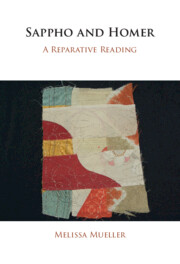Book contents
- Sappho and Homer
- Sappho and Homer
- Copyright page
- Dedication
- Contents
- Acknowledgments
- A Note on Texts and Abbreviations
- Introduction
- Part I Reparative Reading
- Part II Sappho and Homer
- Chapter 3 Plaiting and Poikilia
- Chapter 4 Aphrodite and the Poetics of Shame
- Chapter 5 In the Bardo with Tithonos
- Chapter 6 Sappho fr. 44V, or Andromache’s “No Future” Wedding Song
- Chapter 7 Sappho’s Third Alternative
- Chapter 8 Sapphic Remembering, Lyric Kleos
- Epilogue
- Appendix On the Absence of the Newest Sappho Fragments from this Book
- Works Cited
- Index Locorum
- Subject Index
Chapter 8 - Sapphic Remembering, Lyric Kleos
from Part II - Sappho and Homer
Published online by Cambridge University Press: 07 December 2023
- Sappho and Homer
- Sappho and Homer
- Copyright page
- Dedication
- Contents
- Acknowledgments
- A Note on Texts and Abbreviations
- Introduction
- Part I Reparative Reading
- Part II Sappho and Homer
- Chapter 3 Plaiting and Poikilia
- Chapter 4 Aphrodite and the Poetics of Shame
- Chapter 5 In the Bardo with Tithonos
- Chapter 6 Sappho fr. 44V, or Andromache’s “No Future” Wedding Song
- Chapter 7 Sappho’s Third Alternative
- Chapter 8 Sapphic Remembering, Lyric Kleos
- Epilogue
- Appendix On the Absence of the Newest Sappho Fragments from this Book
- Works Cited
- Index Locorum
- Subject Index
Summary
Taking Penelope’s exemplary remembering of Odysseus as its point of departure, this final chapter argues that Sappho’s lyrics shift the focus of women’s remembering from male to female objects, in this way creating an “avuncular” variation on the Odyssey’s conjugal paradigm. The fragments examined display the “sisterly” dynamics that exist alongside marriage – something the Odyssey itself does not explore. Sappho’s fragments feature the girls and women that wives once were before they were married. The bonds that remembering sustains in Sappho’s world exist alongside the vertically inflected (conjugal, maternal) relationships that more visibly defined a woman’s life. The scenes of recollection are appropriately adorned with lightly woven wreathes, fabrics, flowers, fragrant oils, suggesting the precariousness and fragility of these bonds, in comparision with the supposed enduringness of marriage and patrilineal lineage, with its accumulated household wealth passed on from one generation to the next.
Keywords
- Type
- Chapter
- Information
- Sappho and HomerA Reparative Reading, pp. 175 - 192Publisher: Cambridge University PressPrint publication year: 2023

